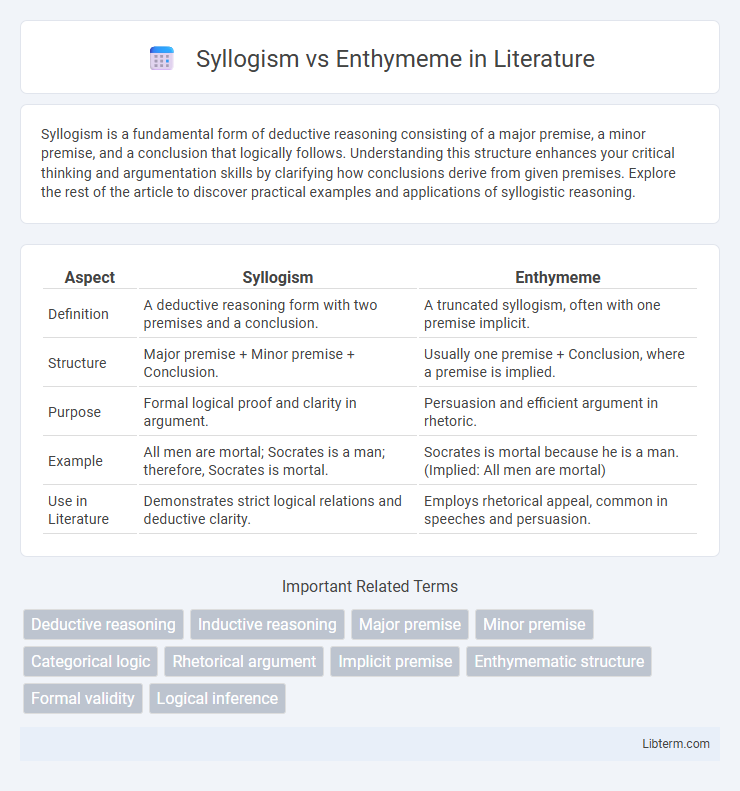Syllogism is a fundamental form of deductive reasoning consisting of a major premise, a minor premise, and a conclusion that logically follows. Understanding this structure enhances your critical thinking and argumentation skills by clarifying how conclusions derive from given premises. Explore the rest of the article to discover practical examples and applications of syllogistic reasoning.
Table of Comparison
| Aspect | Syllogism | Enthymeme |
|---|---|---|
| Definition | A deductive reasoning form with two premises and a conclusion. | A truncated syllogism, often with one premise implicit. |
| Structure | Major premise + Minor premise + Conclusion. | Usually one premise + Conclusion, where a premise is implied. |
| Purpose | Formal logical proof and clarity in argument. | Persuasion and efficient argument in rhetoric. |
| Example | All men are mortal; Socrates is a man; therefore, Socrates is mortal. | Socrates is mortal because he is a man. (Implied: All men are mortal) |
| Use in Literature | Demonstrates strict logical relations and deductive clarity. | Employs rhetorical appeal, common in speeches and persuasion. |
Understanding Syllogism: Definition and Structure
Syllogism is a form of deductive reasoning that consists of two premises and a conclusion, structured to logically derive a conclusion from given statements. It typically involves a major premise, a minor premise, and a conclusion that connects the terms from both premises. Understanding syllogism requires recognizing its formal structure, where each premise provides a basis for validating the conclusion through logical inference.
Enthymeme Explained: Meaning and Key Features
An enthymeme is a rhetorical syllogism used in persuasive speech, characterized by the omission of one premise or the conclusion, relying on the audience's ability to fill in the missing information. It operates on implied reasoning, making arguments more concise and engaging by expecting the listener to infer an unstated premise. Key features of an enthymeme include its persuasive nature, reliance on common knowledge, and efficiency in communication compared to a fully stated syllogism.
Historical Origins: Syllogism and Enthymeme in Classical Rhetoric
Syllogism and enthymeme both originate from classical rhetoric, with Aristotle's works forming the foundation of their historical development. The syllogism is a formal logical structure composed of two premises and a conclusion, designed to demonstrate absolute validity through deductive reasoning. The enthymeme, by contrast, is a truncated syllogism used in persuasive speech that often omits a premise, relying on the audience's ability to fill in the missing information and engage in rhetorical argumentation.
Formal Logic: How Syllogisms Function
Syllogisms function as a cornerstone of formal logic by providing a structured framework that deduces a conclusion from two premises, a major and a minor, each containing a shared term. The validity of a syllogism depends on the precise arrangement of its categorical propositions, ensuring that if the premises are true, the conclusion necessarily follows. Enthymemes, in contrast, are abbreviated syllogisms that often omit one premise, relying on the audience's ability to supply the missing information for the conclusion to hold logically.
Everyday Reasoning: The Role of Enthymemes
Enthymemes play a crucial role in everyday reasoning by allowing individuals to make quick, implicit logical connections without stating every premise explicitly, making communication more efficient and relatable. Unlike syllogisms, which require fully articulated premises and conclusions, enthymemes often rely on shared knowledge and assumptions to persuade or explain in informal contexts. This practical use of enthymemes enables people to navigate daily decisions and arguments effectively, leveraging implicit reasoning to convey ideas succinctly.
Key Differences Between Syllogism and Enthymeme
Syllogisms are complete logical arguments consisting of two premises and a conclusion, while enthymemes are abbreviated arguments that omit one premise, often implied by the audience. Syllogisms offer formal deductive reasoning with explicit structure, making them rigorous and transparent, whereas enthymemes rely on shared knowledge and context, making them persuasive but less formally complete. The key difference lies in their explicitness and completeness: syllogisms present all premises clearly, while enthymemes engage the audience to fill in the missing premise.
Examples Illustrating Syllogisms
Syllogisms consist of two premises and a conclusion, such as "All humans are mortal; Socrates is a human; therefore, Socrates is mortal," demonstrating a clear logical structure. Enthymemes differ by omitting one premise, relying on the audience to fill in the gap, for example, "Socrates is mortal because he is human," where the major premise is implied. These examples highlight the explicit reasoning in syllogisms compared to the implicit assumption in enthymemes.
Examples Demonstrating Enthymemes
Enthymemes are truncated syllogisms where one premise is implicit, making them common in everyday reasoning and persuasive speech. For example, the statement "He must be a good leader because he inspires his team" implies the unstated premise "People who inspire their team are good leaders." Another example, "She can't be guilty; no honest person would do that," assumes the hidden premise "Only dishonest people do that," illustrating how enthymemes rely on shared beliefs to persuade effectively.
Practical Applications: Syllogism vs Enthymeme
Syllogisms serve as fundamental tools in formal logic and legal reasoning, allowing precise deduction from two premises to reach a valid conclusion. Enthymemes, often used in persuasive communication such as advertising and political rhetoric, omit one premise, engaging the audience's ability to infer unstated assumptions. This makes syllogisms ideal for rigorous argument validation, while enthymemes excel in practical contexts where audience interpretation and appeal are crucial.
Choosing Between Syllogism and Enthymeme in Argumentation
Choosing between syllogism and enthymeme in argumentation depends on the audience's familiarity with the topic and the desired level of persuasion. Syllogisms provide a complete logical structure with explicit premises and conclusion, offering clarity and rigor in formal debates or academic contexts. Enthymemes, by omitting one premise, engage the audience's reasoning abilities and are more effective in persuasive speech where assumptions are shared or implied.
Syllogism Infographic

 libterm.com
libterm.com